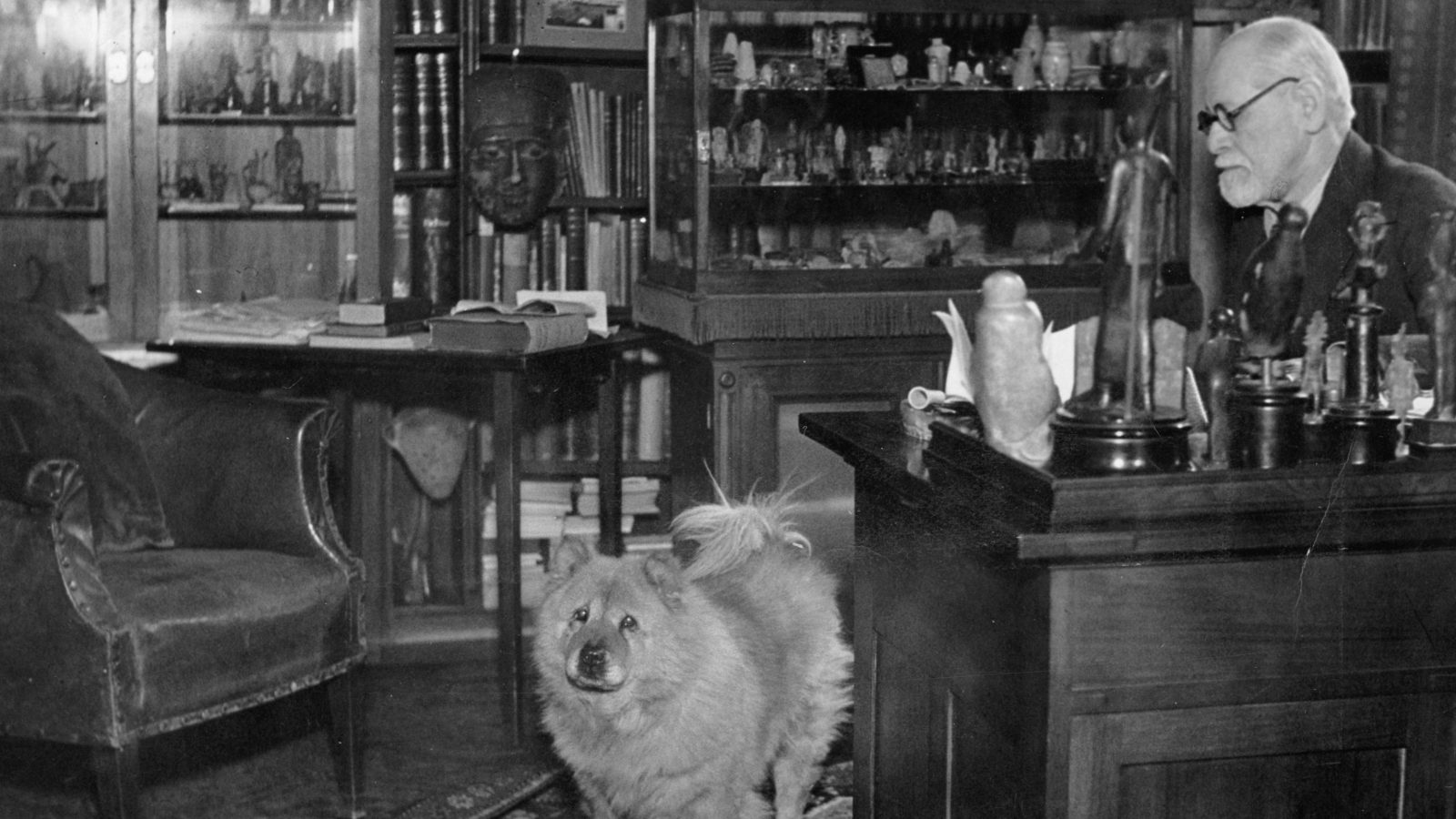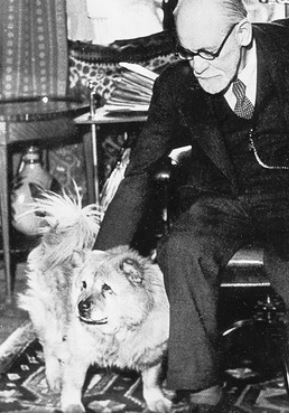

ヨフィ、フロイトの犬
Jofi, Freud's dog


right:Sigmund Freud and Jofi (1937)
☆ ヨフィ(1928年~1937年1月11日)は、精神分析学の創始者であるジークムント・フロイトが飼っていたチャウチャウ犬である。ヨフィはフロイトの 私生活において重要な役割を果たしたことで知られており、人間と動物の絆がもたらすセラピー効果の初期の例としてよく引き合いに出される。フロイトとの親 交、特に晩年におけるその関係は、ペットが心理的な幸福に与える影響を浮き彫りにし、動物介在療法の初期の発展にもつながった。 また、ジョフィの存在と行動は、フロイトがセラピーにおける非言語コミュニケーションを理解する上でも役立った。[1][2] アメリカン・ケネル・クラブは、ジョフィを歴史上最も重要なメス犬のリストに含めた。[3]
| Jofi, also known as
Yofi (1928 – January 11, 1937), was a Chow Chow dog owned by Sigmund
Freud, the founder of psychoanalysis. Known for her significant role in
Freud's personal life, Jofi is often cited as an early example of the
therapeutic benefits of the human-animal bond. Her companionship with
Freud, particularly during his later years, highlights the influence of
pets on psychological well-being and has been linked to the early
development of animal-assisted therapy. Jofi's presence and behavior
also contributed to Freud's understanding of non-verbal communication
in therapy settings.[1][2] American Kennel Club included Jofi in its
list of the most important female dogs in history.[3] |
ヨフィ(1928年~1937年1月11日)は、精神分析学の創始者で
あるジークムント・フロイトが飼っていたチャウチャウ犬である。ヨフィはフロイトの私生活において重要な役割を果たしたことで知られており、人間と動物の
絆がもたらすセラピー効果の初期の例としてよく引き合いに出される。フロイトとの親交、特に晩年におけるその関係は、ペットが心理的な幸福に与える影響を
浮き彫りにし、動物介在療法の初期の発展にもつながった。
また、ジョフィの存在と行動は、フロイトがセラピーにおける非言語コミュニケーションを理解する上でも役立った。[1][2]
アメリカン・ケネル・クラブは、ジョフィを歴史上最も重要なメス犬のリストに含めた。[3] |
| Origins Sigmund Freud did not have any dogs until he was in his seventies. His significant connection with dogs began in the mid-1920s when his daughter, Anna Freud, acquired a German Shepherd named Wolf. Initially intended as a companion for Anna, Freud grew attached to the dog, leading to a notable change in his lifestyle and interests.[4] In 1925, Anna Freud humorously referenced this newfound affection in a birthday note to her father, mentioning that she brought a picture of Wolf as a gift, playfully suggesting Freud's interest had shifted from her to the dog. Explaining why Freud didn't become interested in dogs until later in life, his biographer Ernest Jones wrote, "In the Europe of Freud’s era, Jewish families, like Freud’s, typically did not have close contact with dogs. For them, dogs had fearful associations; for instance, anti-Semites had used attack dogs during the pogroms. The fact that Freud may have overcome some cultural and cognitive inertia to welcome Wolf into his family lends some nuance to his relationship with canines... it became easier to look away from one’s fellowmen and turn to animals."[2] Freud's engagement with dogs deepened in 1928 when Dorothy Burlingham, a friend of Anna, gifted him a Chow Chow named Lün-Yu. Unfortunately, this relationship was short-lived as Lün-Yu passed away 15 months later, having been hit by a train.[5] Freud's response to this event was one of profound grief, akin to mourning a human loss.[4] After a period of seven months, Freud welcomed another Chow Chow, Jofi, who was Lün-Yu's sister, into his household. Freud, proficient in Hebrew, named the dog Jofi, which translates to "beauty" (Hebrew: יופי).[5] During the early 1930s, as Freud's professional relationships and friendships underwent significant changes, with many colleagues either passing away, moving abroad, or becoming estranged, Jofi became an increasingly important presence in his life. She became Freud's constant companion. This period coincided with a phase in Freud's life where he reportedly exhibited uncharacteristic irritability towards his wife, Martha, an indication of broader personal dissatisfaction.[6][7][8] |
起源 ジークムント・フロイトは70代になるまで犬を飼ったことがなかった。彼と犬との重要な関わりは、1920年代半ばに娘のアンナ・フロイトがウルフという 名のジャーマン・シェパードを飼ったときに始まった。当初はアンナのコンパニオンとして飼われたが、フロイトは犬に愛着を抱くようになり、生活スタイルや 関心が著しく変化した。[4] 1925年、アンナ・フロイトはユーモアを交えて父親への誕生日のメッセージの中で、ウルフの写真をプレゼントとして持ってきたことを述べ、フロイトの関 心が自分から犬に移ったことを冗談めかしてほのめかした。フロイトが犬に興味を持つようになったのは、ずっと後のことだったが、その理由について、伝記作 家のアーネスト・ジョーンズは、「フロイトの時代におけるヨーロッパでは、フロイトの家族のようにユダヤ人の家庭では、一般的に犬と親しく接することはな かった。彼らにとって、犬は恐ろしい存在であった。例えば、反ユダヤ主義者たちはポグロムの際に攻撃犬を使用していた。フロイトが文化的・認識的な惰性を 克服してウルフを家族として迎え入れたという事実は、彼と犬との関係に微妙なニュアンスを加えている。それは、同胞から目を背け、動物に目を向けることが 容易になったことを意味している。 1928年、フロイトと犬との関わりは深まった。フロイトの友人であったドロシー・バーリングハムが、リューン・ユーという名のチャウチャウをフロイトに 贈ったのだ。残念ながら、この関係は長くは続かなかった。リューン・ユーは15か月後に列車にはねられ、亡くなってしまったのだ。[5] この出来事に対するフロイトの反応は、深い悲しみであり、人間を失った悲しみにも似ていた。[4] 7ヶ月後、フロイトはリュン・ユの妹であるチャウチャウのヨフィを新たに迎え入れた。ヘブライ語に堪能なフロイトは、この犬に「ヨフィ」という名前をつけ た。これは「美」を意味するヘブライ語(יופי)である。[5] 1930年代前半、フロイトの仕事上の関係や交友関係が大きく変化し、多くの同僚が亡くなったり、海外に移住したり、疎遠になったりする中、ヨフィはフロ イトの生活の中でますます重要な存在となった。彼女はフロイトの常なる伴侶となった。この時期は、フロイトが妻マーサに対して、彼らしくない苛立ちを見せ たと伝えられている時期と重なっている。これは、より広範な個人的な不満の表れであった。[6][7][8] |
| Role in Freud's personal life Shortly after Jofi arrived, he began to express a deep connection with her. He likened his fondness for Jofi to that of his enjoyment of cigars, noting her distinct personality traits. During a period when Freud had to travel to Berlin for medical treatment related to his cancerous jaw, Jofi was placed in kennels, as his wife Martha did not share his affection for dogs. Freud's correspondence with Martha during this time reflected his longing for Jofi, "Is anyone visiting Jofi? I miss her a great deal."[4] At the Freud family home, Jofi was an integral part of daily life. Freud would often share his meals with her, a practice that contributed to Jofi's physical appearance. As Freud's health declined due to cancer, Jofi remained a constant presence, even participating in his professional activities. Freud often experienced pain when eating due to his diseased jaw, Jofi often ended up eating all his dinner. Additionally, Jofi provided emotional support to Freud during his numerous medical procedures. Freud communicated to Princess Marie Bonaparte, a friend, about Jofi's empathetic behavior during his challenging health episodes, suggesting a deep bond between them, "I wish you could have seen with me what sympathy Jofi shows me during these hellish days, as if she understood everything."[4][9][10][11] Jofi had a litter of puppies in 1931, but only one survived. The puppy, named Tatoun, died of distemper in 1931. In 1933, Jofi had another litter of puppies, but this time they were all eaten by Jofi. Jofi had a series of ovarian cysts removed in January 1937. The surgery was successful, but she died of a heart attack three days later on January 11, 1937. Freud was devastated by Jofi's death. He wrote to his friend Arnold Zweig, "Apart from any mourning, it is very unreal, and one wonders when one will get used to it. But, of course, one cannot easily get over seven years of intimacy." Freud had Jofi's body cremated and her ashes scattered in the garden of his home.[4] |
フロイトの私生活における役割 ジョフィが到着して間もなく、彼は彼女との深い絆を表現し始めた。彼はジョフィへの愛情を葉巻を楽しむことになぞらえ、彼女の独特な性格の特徴を指摘し た。フロイトが顎の癌の治療のためにベルリンへ行かなければならなかった時期、ジョフィは犬小屋に入れられていた。なぜなら、妻のマーサは犬を飼うことに 賛成していなかったからだ。フロイトがこの時期にマーサと交わした手紙には、ヨフィへの懐かしさが表れており、「誰かヨフィに会いに来てくれないか? とても会いたい」[4]と書かれている。 フロイトの自宅では、ヨフィは日常生活に欠かせない存在であった。フロイトはヨフィと食事を共にすることが多く、その習慣がヨフィの容姿を保つことに貢献 した。フロイトの健康が癌によって衰えていく中、ヨフィは常に彼のそばにいて、時には彼の仕事にも参加した。フロイトは病気の顎のために食事をする際に痛 みを伴うことが多かったが、ヨフィはしばしば彼の夕食をすべて平らげてしまった。さらに、ヨフィはフロイトが数々の医療処置を受ける間、精神的な支えと なった。フロイトは、友人のマリー・ボナパルト王女に、ヨフィが健康を害した時期に示した共感的な行動について伝え、2人の間に深い絆があることを示唆し た。「地獄のような日々を過ごしている私にヨフィが示してくれた共感の気持ちを、あなたにも見てもらいたかった。まるで彼女がすべてを理解しているかのよ うに。」[4][9][10][11] ヨフィは1931年に子犬を産んだが、生き残ったのは1匹だけだった。タトゥンと名付けられたその子犬は、1931年にジステンパーで死亡した。1933 年、ジョフィはまた子犬を産んだが、今度はその子犬たちをすべてジョフィが食べてしまった。1937年1月、ジョフィは卵巣嚢腫の摘出手術を受けた。手術 は成功したが、その3日後の1937年1月11日、心臓発作で死亡した。フロイトはジョフィの死に打ちのめされた。友人のアーノルド・ツヴァイクに「喪に 服すという以外に、とても現実味がなく、いつ慣れるのかと不思議に思う。しかし、もちろん、7年間の親密な関係を簡単に乗り越えることはできない」と手紙 を書いた。フロイトはヨフィの遺体を火葬にし、その遺灰を自宅の庭に撒いた。[4] |
| Role in Freud's therapy sessions Jofi played a significant role in his therapy sessions. Freud believed dogs possessed an innate ability to understand humans, and he utilized Jofi's presence to assess his patients. Patients tended to be more forthcoming when Jofi was around, and Freud noticed her uncanny ability to sense whether they were anxious or relaxed.[8] Jofi's calming presence in the therapy room helped alleviate tension and create a welcoming atmosphere. She was non-judgmental and served as an attentive listener, providing comfort and support to Freud's patients. Freud also used Jofi's behavior as a tool to study his patients. By observing her reactions to different individuals, he gained insights into their psychological states. Freud often talked through Jofi. Dr. Grinker wrote that if she scratched to be let out, Freud would say, "Jofi doesn't approve of what you're saying." And if she wanted back in, he'd say, "Jofi has decided to give you another chance."[1] Jofi's remarkable sense of time also proved useful in Freud's practice. She would yawn and head towards the door precisely at the 50-minute mark, signaling the end of the session. This consistent behavior helped Freud maintain punctuality and adhere to the standard duration of his sessions.[2] Freud's patients often expressed their appreciation for Jofi's presence in the therapy room. They found her calming demeanor and non-judgmental nature conducive to opening up and sharing their innermost thoughts and feelings. Freud wrote, "Dogs love their friends and bite their enemies, quite unlike people, who are incapable of pure love and always have to mix love and hate in their object relations."[2] Jofi's unique contributions to Freud's psychoanalytic practice highlight the remarkable bond between humans and animals. Her ability to create a safe and supportive environment for patients and her keen intuition regarding their emotional states made her an invaluable asset to Freud's work.[12][13] While Jofi is not directly mentioned in Freud's major psychoanalytic theories, her presence in his life provided Freud with a deeper understanding of instinctual behavior, indirectly influencing his work. Freud's relationship with Jofi and his other dogs is a subject of interest among scholars for its potential influence on his theories.[14][15] Jofi is recognized for her contribution to the early stages of animal-assisted therapy. Her companionship with Freud serves as an early example of the therapeutic potential of the human-animal bond, offering insight into a personal facet of Freud's life.[8][16][17] |
フロイトのセラピーセッションにおける役割 ジョフィは、彼のセラピーセッションにおいて重要な役割を果たした。フロイトは、犬には生まれつき人間を理解する能力があると考えており、ジョフィの存在 を利用して患者を評価していた。ジョフィがそばにいると、患者は打ち解けやすくなる傾向があり、フロイトは、患者が不安なのかリラックスしているのかを感 知する彼女の並外れた能力に気づいた。 治療室でのヨフィの落ち着いた存在感は、緊張を和らげ、温かい雰囲気を作り出すのに役立った。彼女は批判的な態度をとらず、注意深く耳を傾ける聞き手とな り、フロイトの患者たちに安らぎとサポートを提供した。また、フロイトはヨフィの行動を患者を研究するツールとしても活用した。さまざまな人物に対するヨ フィの反応を観察することで、フロイトは彼らの心理状態について洞察を得た。フロイトはヨフィを通じてよく話した。グリンカー博士は、ヨフィが引っ掻いて 外に出たいと訴えた場合、フロイトは「ヨフィはあなたが言っていることを認めていない」と答えたと書いている。また、ヨフィが家の中に戻りたいと訴えた場 合、フロイトは「ヨフィはあなたにもう一度チャンスを与えることにした」と答えたという。[1] ヨフィの優れた時間感覚はフロイトの診療にも役立った。彼女は50分ちょうどに欠伸をしてドアに向かい、セッションの終了を告げた。この一貫した行動により、フロイトは時間を守るようになり、セッションの標準的な時間を厳守するようになった。 フロイトの患者たちは、ヨフィがセラピールームにいることに感謝の意を表することが多かった。彼らは、彼女の落ち着いた態度と非批判的な性格が、心を開い て最も内密な考えや感情を打ち明けるのに役立つと感じていた。フロイトは、「犬は友人を愛し、敵を噛む。人間とは全く異なり、人間には純粋な愛情を持つこ とができない。人間は愛情と憎しみを対象関係に混ぜ合わせなければならない」と書いている。[2] フロイトの精神分析の実践に対するジョフィのユニークな貢献は、人間と動物との間に存在する驚くべき絆を浮き彫りにしている。 患者にとって安全でサポート的な環境を作り出す能力と、患者の感情状態に対する鋭い直感は、ジョフィをフロイトの仕事にとってかけがえのない存在にした。 [12][13] ジョフィはフロイトの主要な精神分析理論では直接言及されていないが、彼女がフロイトの人生に存在したことは、フロイトに本能的な行動に対するより深い理 解をもたらし、間接的に彼の仕事に影響を与えた。フロイトとジョフィ、そして他の犬たちとの関係は、彼の理論に影響を与えた可能性があるとして、学者たち の関心を集めている。[14][15] ジョフィは、動物介在療法の初期段階への貢献が認められている。彼女とフロイトの関係は、人間と動物の絆が持つ治療効果の初期の例であり、フロイトの人生 の個人的な側面についての洞察を提供している。[8][16][17] |
| Successor In 1937, following the death of Jofi, Sigmund Freud acquired another chow, whom he also named Jofi. The subsequent year, amidst rising Nazi persecution, the Freud family relocated from Vienna to London. Their new residence later became known as the Freud Museum. After enduring a six-month quarantine, Jofi II was reunited with Freud, an event that garnered attention from the local press in London. Freud's life came to an end shortly thereafter in 1939, at the age of 83, and Jofi II outlived him by several years.[2][4] In popular culture Jofi's story and her relationship with Freud have been featured in various media, including print and video. These portrayals often focus on the unique bond between Freud and his pet, emphasizing the impact of Jofi on Freud's personal and professional life.[18][19][20] In the 1997 book What Do Dogs Know? by Stanley Coren, he writes about how Freud used Jofi to help him assess his patients.[21] In the 2001 play Freud's Last Session, Jofi is mentioned as being a source of comfort for Freud during his final days.[22] In the 2011 film A Dangerous Method, Jofi is portrayed by a dog named Bailey.[23] |
後継者 1937年、ヨフィの死後、ジークムント・フロイトは別の犬を飼い、やはりヨフィと名付けた。翌年、ナチスの迫害が強まる中、フロイト一家はウィーンから ロンドンへと移住した。彼らの新しい住居は後にフロイト博物館として知られるようになった。6か月の隔離期間を経て、ヨフィ2世はフロイトと再会し、この 出来事はロンドンの地元紙の注目を集めた。フロイトは1939年に83歳で亡くなり、ヨフィ2世はフロイトより数年長生きした。[2][4] 大衆文化において、 ジョフィの物語や彼女とフロイトの関係は、印刷物や映像など、さまざまなメディアで取り上げられてきた。これらの描写では、フロイトとペットの間に築かれた独特な絆に焦点が当てられ、フロイトの公私にわたる生活にジョフィが与えた影響が強調されていることが多い。 1997年に出版されたスタンリー・コーレン著『犬に何がわかるか?』では、フロイトがヨフィを患者の診断に役立てていたことが書かれている。[21] 2001年の演劇『フロイト最後のセッション』では、ヨフィは晩年のフロイトにとって心の支えであったとされている。[22] 2011年の映画『危険なメソッド』では、ヨフィはベイリーという名の犬によって演じられている。[23] |
| https://en.wikipedia.org/wiki/Jofi |
|
リ ンク
文 献
そ の他の情報
Copyleft, CC, Mitzub'ixi Quq Chi'j, 1996-2099
☆
 ☆
☆